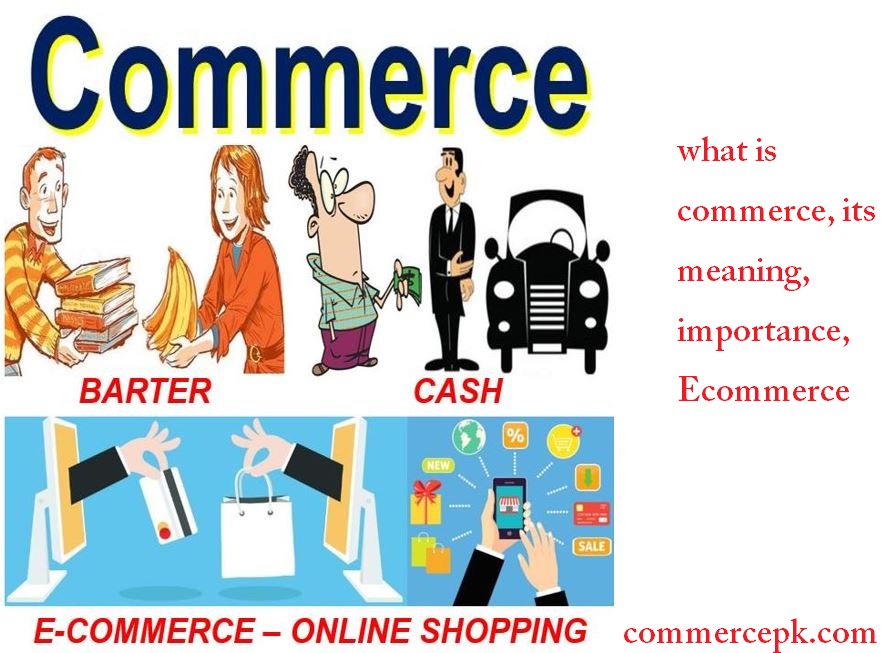“Commerce is the activity of buying and selling of goods and services, especially on a large scale or quantity”
When student gets passed his matric or o level and promote to college & those who select commerce & management science field, people always asks them what is commerce ? & students always in confusion and suddenly said commerce is trade but actually it is not just a trade below a complete detailed article about “what is Commerce“.
Commerce Dictionary Meaning:
“The activity of buying and selling, especially on a large scale”
If you are searching for a topic what is commerce, then your are at the right destination.
What is Commerce ?
Commerce is very significant part of a business. It is concerned with the buying and selling of goods. It includes all those activities which are related to the transfer of goods from occupations deals with buying and selling of goods, the exchange of commodities and the distribution of the finished goods.
Meaning of Commerce:
Commerce is a branch of business. It is concerned with the exchange of goods and services. It includes all those activities, which directly or indirectly facilitate that exchange.
Definition of Commerce: By different Authors
Concrete definition of commerce:
“Commerce is that part of the business which is concerned with the exchange of goods and services and includes all those activities which directly or indirectly facilitate that exchange.”
According to James Stephenson
“Commerce is an organized system for the exchange of goods between the members of the industrial world.

Evolution of Commerce:
Following are the stages in the evolution of commerce.
- Non-Existence of Commerce and Trade:
In the early stages of man, there were no surpluses to be exchanged. Our original ancestors consumed what they produced. The production of goods was only to satisfy one’s own need. Meanwhile, people did not exchange goods or services commerce and were no existent.
- Barter Economy:
Human wants to increase with the advance of civilization. They could not produce everything, they needed. People came to known that man is skillful in producing a few commodities. He can make them quite rapidly in large numbers and in beautiful forms. So, at this stage, people started producing an excess of their needs what they could produce. People started searching for persons who could get their surplus products in exchange for those goods, which they required. Commerce made its beginning and barter exchange of goods for goods began to be practiced. Means of communication were either absent or wholly primitive and trade was non-existent. - National Economy:
The introduction of money followed by several other improvements of commercial activities transportation, banking insurance etc. significantly helped to develop commerce and trade. The division of work and specialization helped producers to concentrate on few products only. They started producing goods not only for the local markets but also for the national markets.

Functions of Commerce:
- Removing the difficulty of persons:
Trade removes the difficulty of persons by creating a link between the producers and consumers.
- Removing the difficulty of time:
Warehousing removes the difficulty of time by removing the time gap between the production and consumption.
- Removing the difficulty of place:
Transport removes the difficulty of place by removing a place gap between the producers and consumers.
- Removing the difficulty of finance:
Banking removes the difficulty of finance by helping the buyers and sellers in making and receiving payments and providing them credit facilities. Even now a day E-payment make easier and facilitate business.
- Removing the difficulty of risk:
Insurance removes the difficulty of risk by providing protection and compensation to the insured against various types of risks. You can insure your business’s stock or fire insurance against monthly premium.
- Removing the difficulty of knowledge:
Advertising removes the difficulty of knowledge by making people aware about the product and related particulars.
Also Read:
Classification of Commerce:
It is also called the Elements of Commerce and can be classified into two categories:
1. Trade.
2. Aids to trade.
1. Trade:
In simple words, trade means buying and selling. It is the exchange of goods and services among buyer and seller in which both the parties are benefited.
Trade is also divided into different types.

a. Internal trade
b. External trade
c. Wholesale trade
d. Retail trade
You may also like to Read:
a. Internal Trade:
The buying and selling of goods within the boundary of a country are called internal trade.
b. External Trade:
External trade means any purchase and sale of goods between two countries .it is called foreign trade.
c. Wholesale trade:
The wholesale trade involves the purchase of goods in large quantities from producers and the resale to retailers. The retailers sell those goods to consumers.
d. Retail trade:
The retail trade consists of all the activities which are related to a sale of goods and services to the final consumers. Here goods are sold in small quantities to the consumers.
2. Aid to Trade:
The activities which facilitate in the purchase of goods and services are called aid to trade. The aid which are essential for the expansion of the trade are as follow.
1. Transport:
Transport is a vital element in commerce. The different means of transport trucks, buses, railways, ships, airplanes etc help in carrying goods from the places of production to centers of consumption. Transport ensures movement of goods and services from one place to another. It not only extends the market of goods but also increases the mobility of labor and capital.
2. Insurance:
Insurance is another important element in commerce. The risk of damages of goods from flood earthquake fire and other causes is covered by insurance. The insurance companies make good the loss of commodities due to fire floods etc to the traders on payment of insurance premiums. Insurance thus helps in the expansion of trade.
3. Banking:
The commercial banks play an important role in financing the various trade activities. They finance the traders for stock holding and transportation of goods. They also assist the buyer and selling of goods in receiving and making payments both at the national and international level. The finance or credit is provided to the trader in the form of Cash credit overdrafts and loans.
4. Warehousing:
Warehousing is a kind of storage. Now-a-days most of the goods are produced in expectation of demand. They are stored in safe places and are released as and when demanded in the market. Warehousing thus helps in overcoming the barrier of time and creates time utility.
5. Advertisement:
Selling of goods is the most important and difficult problem for the manufacturer. An advertisement about the product through newspaper, magazines, TV, internet helps etc has greatly helped the consumer in choosing the goods of their taste.
The consumer comes to know about the quality and price of the good in a short time and pick up the product that suits them. Advertisement thu威而鋼
s has increased the sale of goods.
6. Agents:
There is a long chain of middlemen (wholesaler, retailers, brokers) who act as agent between the producers and the consumer .they bring the sellers and buyer of goods together and help them in completing the transaction of goods. These agents act for commission .the mercantile agents thus have greatly helped in the distribution of goods from the producers to the consumers.
Four Importance of Commerce:
- Satisfy human Wants Commerce tries to satisfy human wants. Human wants can be categorized as Basic wants and Secondary wants. Human wants can’t be ending. Commerce has made a distribution of goods potential from one part of the world to the other part.
Nowadays we can purchase anything produced anywhere in the world office line as well as online. This has enabled man to satisfy his uncountable wants and thereby promoting social welfare.
- Commerce links producers and consumers: Production is meant for ultimate consumption. Commerce makes possible to link producers and consumers through retailers and wholesalers and also through the aids to trade. Consumers get information about different goods through advertisements and salesmanship. The manufacturers are commonly up-to-date about the likes and dislikes of the consumers through marketing research. Thus commerce creates contact between the centers of production and consumption and links them.
- Increase living Standard: Commerce has increased our standard of living. The standard of living. It refers to a quality of life enjoyed by the members of a society. In simple words when a man consumes more products his standard of living improves. To consume a multiplicity of goods he must be able to secure them first. Commerce helps us to get what we want at right time, right place and at the right price and thus helps in improving our living standard.
- Generates employment opportunities Commerce has generated a lot of opportunities for the world. The growth of commerce, industry, and trade bring about the growth of agencies of trade such as insurance, transport, warehousing, banking, advertising, etc. These agencies need people to look after their operational. An increase in production results in increasing demand, which further results in improving employment opportunities. Thus the growth of commerce generates more and more employment opportunities for millions of people in a country.
what is commerce subject:
Commerce is also a subject taught in college and University levels. The students who choose D.com or DBA after matric or O Level they will found “Principles of Commerce” in their course.
what is Commerce degree:
You can do a Bachelor of commerce (B.com) or Masters in Commerce (M.Com) where you will learn Commerce and all the related subjects. The degree of commerce enhanced your skills of business, management, and accounting.
This is all about Commerce and I hope after reading this article you get all the knowledge about ‘what is commerce and its meaning’. If you need more explanation about What is commerce and its importance you can visit,
